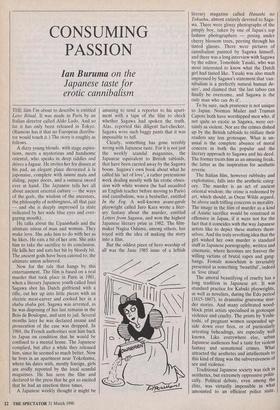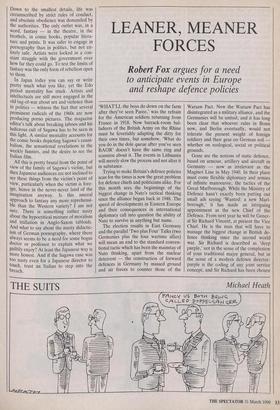CONSUMING PASSION
Ian Buruma on the
Japanese taste for erotic cannibalism
THE film I'm about to describe is entitled Love Ritual. It was made in Paris by an Italian director called Aldo Lado. And so far it has only been released in Tokyo. (Rumour has it that no European distribu- tor would touch it.) The story is roughly as follows.
A dizzy young blonde, with stage aspira- tions, meets a mysterious and handsome oriental, who speaks in deep riddles and drives a Jaguar. He invites her for dinner at his pad, an elegant place decorated a la japonaise, complete with tatami mats and sliding, paper doors, and a samurai sword ever at hand. The Japanese tells her all about ancient oriental culture — the ways of the gods, the wisdom of the ancestors, the philosophy of nothingness, all that jazz — and she is deeply impressed (a state indicated by her wide blue eyes and ever- gaping mouth).
He talks about the Upanishads and the ultimate union of man and woman. They make love. She asks him to do with her as he likes. He eats a bit of her arm. She asks him to take the sacrifice to its conclusion. He kills her and eats her bit by bloody bit. The ancient gods have been catered to; the ultimate union achieved.
Now for the talc that hangs by this entertainment. The film is based on a real murder that took place in Paris in 1981, when a literary Japanese youth called Issei Sagawa shot his Dutch girlfriend with a rifle, cut her up into little pieces with an electric meat-carver and cooked her in a shabu shabu pot. Sagawa was arrested, as he was disposing of her last remains in the Bois de Boulogne, and sent to jail. Several months later he was declared insane and prosecution of the case was dropped. In 1984, the French authorities sent him back to Japan on condition that he would be confined to a mental home. The Japanese complied, but after a while they released him, since he seemed so much better. Now he lives in an apartment near Yokohama, where his dates with, mostly foreign, girls are avidly reported by the local scandal magazines. He has seen the film and declared to the press that he got so excited that he had an erection three times.
A Japanese weekly thought it might be amusing to send a reporter to his apart- ment with a tape of the film to check whether Sagawa had spoken the truth. Alas, reported this diligent fact-checker, Sagawa wore such baggy pants that it was impossible to tell.
Clearly, something has gone terribly wrong with Japanese taste. For it is not just the weekly scandal magazines, the Japanese equivalent to British tabloids, that have been carried away by the Sagawa boom. Sagawa's own book about what he called his 'act of love', a rather pretentious work dealing mostly with his erotic obses- sion with white women (he had assaulted an English teacher before moving to Paris) and cannibalism, was a bestseller, entitled In the Fog. A well-known avant-garde playwright called Juro Kara wrote a liter- ary fantasy about the murder, entitled Letters from Sagawa, and won the highest Japanese literary prize in 1982. The film- maker Nagisa Oshima, among others, has toyed with the idea of making the story into a film.
But the oddest piece of hero worship of all was the June 1985 issue of a leftish literary magazine called Hanashi no Tokushu, almost entirely devoted to Saga- wa. There were glossy photographs of the pimply boy, taken by one of Japan's top fashion photographers — posing under cherry blossom trees, peering through his tinted glasses. There were pictures of cannibalism painted by Sagawa himself, and there was a long interview with Sagawa by the editor, Tomohide Yasaki, who was most interested to know what the Dutch girl had tasted like. Yasaki was also much impressed by Sagawa's statement that 'can- nibalism is a perfectly natural human de- sire', and claimed that 'the last taboo can finally be overcome, and Sagawa is the only man who can do it'.
To be sure, such prurience is not unique to Japan. Norman Mailer and Truman Capote both have worshipped men who, if not quite so exotic as Sagawa, were cer- tainly as violent. Nor are the crimes dished up by the British tabloids to titillate their readers any less grotesque. What is un- usual is the complete absence of moral concern in both the popular and the literary approach to Sagawa and his deed. The former treats him as an amusing freak, the latter as the inspiration for aesthetic reverie.
The Italian film, however rubbishy and exploitative, falls into the aesthetic categ- ory. The murder is an act of ancient oriental wisdom; the crime is redeemed by art, which should, as Oscar Wilde argued, be above such trifling concerns as morality. The image in the film of murder as a kind of Asiatic sacrifice would be construed as offensive in Japan, if it were not for the fact that it coincides with the way Japanese artists like to depict these matters them- selves. And the truly revolting idea that the girl wished her own murder is standard stuff in Japanese pornography, written and cinematic, where heroines are forever the willing victims of brutal rapes and gang- bangs. Female masochism is invariably presented as something 'beautiful', indeed as 'love ritual'.
The amoral beautifying of cruelty has a long tradition in Japanese art. It was standard practice for Kabuki playwrights, as well as novelists, during the Edo period (1615-1867), to dramatise gruesome mur- der stories. And many celebrated wood- block print artists specialised in grotesque violence and cruelty. The prints by Yoshi- toshi, of pregnant women suspended up- side down over fires, or of particularly arresting beheadings, are especially well known. Like everywhere else, urban Japanese audiences had a taste for violent fantasy and sensational crimes. What attracted the aesthetes and intellectuals to this kind of thing was the subversiveness of sex and violence.
Traditional Japanese society was rich in aesthetics, but extremely oppressive politi- cally. Political debate, even among the elite, was virtually impossible in what amounted to an efficient police state. Down to the smallest details, life was circumscribed by strict rules of conduct, and absolute obedience was demanded by the authorities. The only outlet was, in a word, fantasy — in the theatre, in the brothels, in comic books, popular litera- ture and prints. It was safer to engage in pornography than in politics, but not en- tirely safe. Artists were locked in a con- stant struggle with the government over how far they could go. To test the limits of fantasy was the only form of rebellion open to them.
In Japan today you can say or write pretty much what you like, yet the Edo period mentality has stuck. Artists and intellectuals are still more engaged in the old tug-of-war about sex and violence than in politics — witness the fact that several prominent radicals of the 1960s are now producing porno pictures. The magazine editor's talk about breaking taboos and his ludicrous cult of Sagawa has to be seen in this light. A similar mentality accounts for the comic books depicting Sagawa's canni- balism, the sensational revelations in the weekly funnies, and the desire to see the Italian film.
All this is pretty brutal from the point of view of the family of Sagawa's victim, but then Japanese audiences are not inclined to see these things from the victim's point of !new, particularly when the victim is fore- ign, hence in the never-never land of the imagination anyway. Is this amoral approach to fantasy any more reprehensi- ble than the Western variety? I am not sure. There is something rather nasty about the hypocritical mixture of moralism and titillation in Anglo-Saxon tabloids. And what to say about the musty didactic- ism of German pornography, where there always seems to be a need for some bogus doctor or professor to explain what we guiltily enjoy? At least the Japanese way is more honest. And if the Sagawa case was too nasty even for a Japanese director to touch, trust an Italian to step into the breach.



























































 Previous page
Previous page